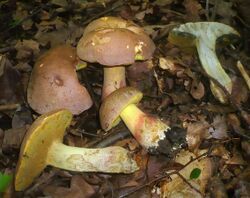Biology:Butyriboletus fechtneri
| Butyriboletus fechtneri | |
|---|---|

| |
| Scientific classification | |
| Domain: | Eukaryota |
| Kingdom: | Fungi |
| Division: | Basidiomycota |
| Class: | Agaricomycetes |
| Order: | Boletales |
| Family: | Boletaceae |
| Genus: | Butyriboletus |
| Species: | B. fechtneri
|
| Binomial name | |
| Butyriboletus fechtneri (Velen.) D.Arora & J.L.Frank (2014)
| |
| Synonyms | |
| |
Butyriboletus fechtneri is a basidiomycete fungus in the family Boletaceae. It was formerly regarded as a species of Boletus, but in 2014 was transferred to the newly erected genus Butyriboletus, after molecular data revealed that it is a member of the "Regius" clade (named after B. regius), quite distant from the core clade of B. edulis and closely allied species.[1][2]
Butyriboletus fechtneri is native to Europe, where it forms ectomycorrhizal associations with various broad-leaved trees of the family Fagaceae, particularly oak (Quercus), beech (Fagus) and chestnut (Castanea).[3][4][5] So far it has been molecularly confirmed from Austria, Bulgaria, Cyprus, Estonia, France , Spain and Sweden.[6] It is considered an endangered species in the Czech Republic.[7]
Recent molecular phylogenetic studies have shown regional populations of B. fechtneri to be highly variable genetically, suggesting they might be in the process of speciation.[6][8]
References
- ↑ "Phylogenetic overview of the Boletineae". Fungal Biology 117 (7–8): 479–511. 2013. doi:10.1016/j.funbio.2013.04.008. PMID 23931115.
- ↑ Arora D, Frank JL. (2014). "Clarifying the butter Boletes: a new genus, Butyriboletus, is established to accommodate Boletus sect. Appendiculati, and six new species are described". Mycologia 106 (3): 464–80. doi:10.3852/13-052. PMID 24871600.
- ↑ Muñoz JA. (2005). Fungi Europaei 2: Boletus s.l.. Italy: Edizioni Candusso. ISBN 978-88-901057-6-0.
- ↑ Galli R. (2007) (in it). I Boleti. Atlante pratico-monographico per la determinazione dei boleti (3rd ed.). Milano, Italy: Dalla Natura.
- ↑ Assyov B. (2012). "Revision of Boletus section Appendiculati (Boletaceae) in Bulgaria with a key to the Balkan species". Turkish Journal of Botany 36: 408–19. doi:10.3906/bot-1104-10. http://journals.tubitak.gov.tr/botany/issues/bot-12-36-4/bot-36-4-13-1104-10.pdf.
- ↑ 6.0 6.1 "Present status and future of boletoid fungi (Boletaceae) on the island of Cyprus: cryptic and threatened diversity unraveled by 10-year study.". Fungal Ecology 41 (13): 65–81. 2019. doi:10.1016/j.funeco.2019.03.008.
- ↑ Mikšik M. (2012). "Rare and protected species of boletes of the Czech Republic". Field Mycology 13 (1): 8–16. doi:10.1016/j.fldmyc.2011.12.003.
- ↑ "Phylogenetic and distributional data on boletoid fungi (Boletaceae) in Cyprus and description of a new sampling methodology.". Data in Brief 25: 1–11. 2019. doi:10.1016/j.dib.2019.104115. PMID 31453275.
External links
Wikidata ☰ Q17153038 entry
 |

